Archived Mold Remediation Blog Posts
Can My Favorite Items Be Saved From Mold Damage?
6/17/2020 (Permalink)
The presence of mold, whether it comes from water damage or high moisture, can permanently damage your possessions. While there are items you should throw away, such as food and medicine, there are others with sentimental value you might not want to get rid of. Mold cleaning, especially when handled by mold remediation specialists, can bring back some of these possessions with no health hazards and no permanent damage!
Here are some items that we can save:
Leather Items
Leather can be an appealing choice for several items in your household. It can have a classy look that also brings extra warmth to the user.
- Jackets
- Furniture
- Baseballs and baseball mitts
- Briefcases
- Purses
It can be difficult to dispose of these leather items if they suffer from mold damage. Thankfully, there are chemicals that can clean and fight the mold's mycotoxin, such as borax and tea tree oil. Ultimately, a remediation technician will make the final call depending on the item and damage.
Clothing
Nothing can be more frustrating than seeing mold grow over your favorite clothes. Just as with leather, there are a variety of mold cleaning products such as hot water, vinegar, bleach, or borax. There are even specialized laundry machines designed to remove all types of damage from clothes, including mold and mildew. Use these resources depending on the clothing's specifications so the cleaners avoid damaging them. Once again, consult with cleaning specialists for the best solution.
Paintings
The paintings in your residence may effectively decorate your home but salvaging them from mold growth can be difficult. Painting over the mold is not recommended, as the paint can peel off and the toxins can remain. Instead, consult a specialist that can remove the mold safely with the right tools and chemicals.
Even though mold can ruin many of your priceless possessions, they are not always beyond saving. Research mold cleaning professionals and techniques to bring your prized possession to former glory and when in doubt, just give us a call! 636-537-5400.
Removing Mold From Your HVAC System
6/11/2020 (Permalink)
Is there a musty smell when you turn on your HVAC system? If so, listen up.
Mold can easily spread through your ducts, vents, and HVAC system, leaving a nasty haze of mold that you can smell all over the house. If you're running a business, your customers could smell it too- which is why you should always call our service professionals to deal with the problem as soon as possible.
How Does Mold Get in The HVAC System?
Mold damage in Chesterfield, MO is no laughing matter. Mold, fungus, and other bacteria are in their perfect environment when they're trapped in your HVAC system. It's dark, warm, closed in, and humid, meaning that spores can grow incessantly. You'll notice more and more of a scent as heat and humidity are generated from outside and pulled through your ducts.
When this moist air gets in your air system, it collects within and above your HVAC units. At this point, the spores of mold and other fungi easily rise through the air, setting up colonies as your condenser forces them up through the duct system. These aren't the only cases of mold that we've seen at SERVPRO; we've seen mold stick to people's clothes or shoes, and it's all brought inside by excess humidity caused by rainfall!
Tips on How to Remove Mold From Your HVAC System
1. Continue to clean and maintain your HVAC system, even when you aren't using it. Check the ducts for wet spots, and regularly check and maintain your HVAC filter.
2. Double-check the drainage systems on your HVAC for mold. Allow for "dry-out" areas where the drainage comes out to prevent excess moisture.
3. Get dehumidifiers for your home. They are ideal for collecting excess humidity, and they help with the temperature inside your house, too.
4. Always insulate your pipes, walls, and ceilings. Use caulking for cracks to control cracks and leaks.
5. Contrary to common beliefs, keep your windows closed when it's hot outside. Humidity, dust, and dampness easily travel inside.
Don't hesitate to call SERVPRO of South Chesterfield/Wildwood. We are here for you 24 hours a day and 365 days of the year! Call us today to make your mold damage look “Like it never even happened.” 636.537.5400
Helping Our Realtors With Mold Damage
5/8/2020 (Permalink)
As a realtor, you work hard at finding people a place they can call home. You also work hard at presenting less-than-desirable houses in a way that suddenly appears like home to someone else. In doing so, sometimes mold is one of the battles you pursue. At SERVPRO of South Chesterfield/Wildwood, we want to help!
Be an Informed Resource
Molds are found in every environment. Excessive dampness indoors encourages the growth of molds and other organisms, causing a public health problem. The EPA advised that the potential health concerns from molds are an important reason to prevent moisture problems leading to mold growth. It is especially important to clean up existing indoor mold growth to increase property appeal and retain its value. If a property has experienced a water intrusion, SERVPRO of South Chesterfield/Wildwood can inspect the damage to see whether moisture has penetrated materials or is allowing mold growth.
Control Moisture- Reduce Mold
Before listing a property, the following steps can be taken to reduce the potential for moisture buildup or mold growth. Should mold damager occur, a timely response is key to preventing further damage--act within the first 24 to 48 hours. Here are a few things you can do:
- Correct any water leaks or standing water
- Remove standing water under cooling coils or air handling units
- Properly maintain humidifiers, if used
- Replace wet or visibly moldy insulation materials
- Install a ventilation system
3 Facts You Need To Know About Mold
4/16/2020 (Permalink)
Where there is water damage there is the possibility of mold. Have you ever noticed a musty smell in one central location but you’re not sure where it’s coming from? If you answered yes, that means at some point you have probably had some type of water damage that went untreated and mold has developed. There’s no need to panic though, SERVPRO of South Chesterfield/Wildwood can make it look “Like it never even happened." Here are three facts you need to know about mold.
3 facts about mold damage
- Mold is present almost everywhere, indoors and outdoors.
- Mold spores are microscopic and float along in the air. Spores can enter your home through windows, doors, AC/heating system, and can even hitch a ride on your clothing or your pets!
- Mold spores thrive on moisture. Spores can quickly grow into colonies when exposed to water. These colonies may produce allergens and irritants.
Confusion and misunderstanding surround the topic of mold and mold remediation. Some restoration businesses even make claims to remove all mold from a building. This is a fallacy. It is impossible to remove all mold because mold spores occur naturally both indoors and outdoors.
When there’s mold damage at your home or business, count on the company that fits the “mold!” SERVPRO of South Chesterfield/Wildwood is your local remediation and restoration company. Our heroes specialize in mold remediation. Call (636)537-5400 for your solution!
Limiting Mold Exposure in Your Home
9/26/2019 (Permalink)
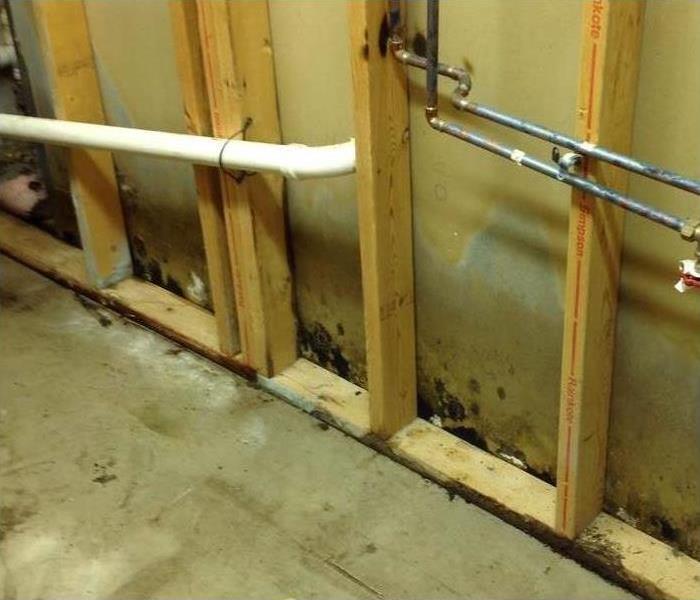 Mold damage in Ballwin, MO
Mold damage in Ballwin, MO
Limiting Mold Exposure in Your Home
Have you recently experienced water damage from a busted pipe? Did the washing machine overflow? Does your home feel particularly humid? If so, your property might be vulnerable to mold. Take action quickly. If you suspect an issue, contact a mold restoration company in Ballwin, MO, to inspect the residence. In the meantime, these three tips might help keep a small problem from becoming a potential disaster.
1. Contain It
For mold prevention, limit your home's exposure to spores. The fewer the house has, the less likely it is that a problem might develop. Have you spent time walking in the grass? Did you enjoy a day outside? Spores live in the air and on the ground, so just by walking inside you could be trekking them into your abode. Upon entry, leave shoes and possessions near the door, preventing dirt and fungus from spreading throughout the rooms. In addition, avoid leaving doors and windows open and regularly caulk gaps in outdoor vents. If you're still concerned, research and purchase a high-end air filtration system.
2. Dry It Out
Mold reproduces when its spores react with liquid. Focus, therefore, on pulling moisture out of the air and preventing water damage. To reduce the home's humidity levels, keep the air conditioner running and properly serviced. If that's not enough, add a dehumidifier or buy moisture-absorbing products. Taking a shower? Use your bathroom vents to pull wetness out of the air. Has the dryer been on the fritz? Have it cleaned out. A clogged vent could increase the steaminess in that area.
3. Fix It, Clean It, Remove It
Has a pipe recently leaked? Did the air unit get clogged, spilling over onto the carpet? These water sources can lead to mold growth. Experts need to address the problem as well as remove any damaged materials. Without proper care, this trouble could reoccur, causing further headache and frustration.
Be proactive to protect your home and pocketbook. Work to keep spores out and minimize dampness. Then, if water damage occurs, don't neglect it. Have the area professionally sanitized and repaired. Allow the crew to help your home look “Like it never even happened.”
How Quickly Can Mold Grow After a Flooding Event?
7/24/2019 (Permalink)
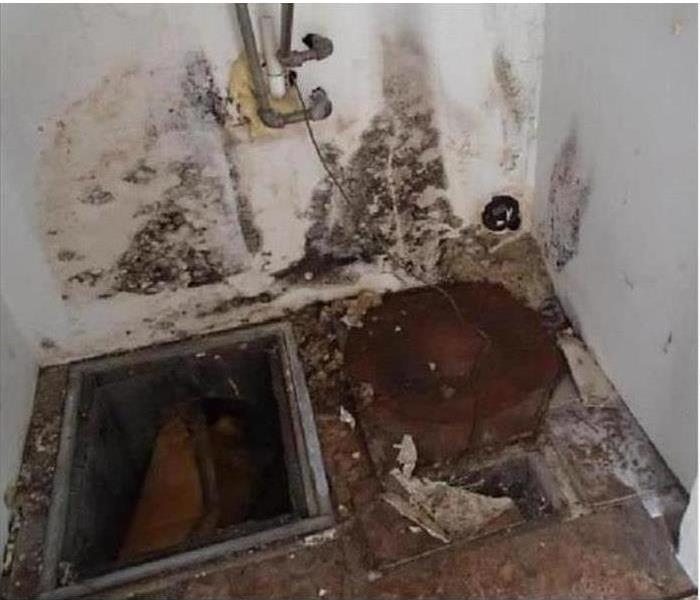 Broken pipe causes mold damage in Ellisville, MO
Broken pipe causes mold damage in Ellisville, MO
Why Mold Is So Opportunistic?
If your building in Ellisville, MO, is flooded in some manner, water damage is a major concern. Whether the flooding is due to severe weather conditions, damaged water or heating pipes indoors, a leaking roof or from another cause, there can be serious consequences. Mold can grow following a flooding event and can quickly spread. Mold is a type of fungus that is well-suited to take advantage of damp areas inside buildings. Below are the reasons why mold is so opportunistic following a flooding event indoors.
1. Mold Growth Can Be Rapid
It can take as little as 24 to 48 hours for mold to begin growing on a water-damaged surface. This rapid growth rate may leave very little time to clean up the water before mold takes hold.
2. Mold Does Not Discriminate
Mold is a very hardy fungus that can grow on nearly any damp surface. There does not need to be a large flood to allow mold to grow. Even something as simple as a slow leak from a pipe that causes minor water damage nearby can generate enough moisture to support mold.
3. Mold Needs Very Little to Survive
Mold requires moisture, and very little else, to grow and thrive. Because it is so resilient, it is very easy for it to begin growing in areas where it is not expected. Many people believe a serious flood must occur inside a building for mold to appear, but that is not true. This is why mold prevention is key to keeping the fungus from flourishing.
Any level of flooding or water infiltration inside a building is enough to cause concern regarding mold, whether it is a very small leak or a large flood. Hiring the services of mold remediation specialists to help survey the damage and clean up the mess may be a good option. Keep in mind that any time water damage occurs, mold can soon follow.
Commercial Mold Remediation in Chesterfield,Mo
3/21/2018 (Permalink)
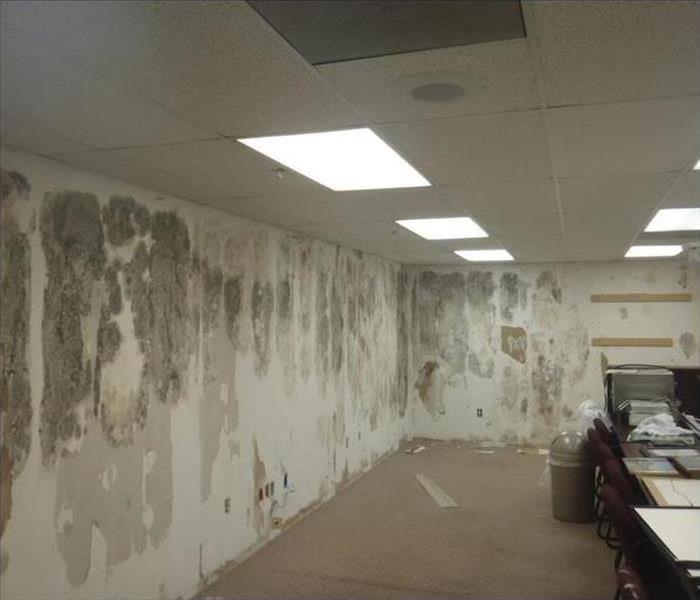 Mold behind wall coverings.
Mold behind wall coverings.
Commercial Mold Remediation
Besides causing a major business interruption, a mold problem can present a serious health risk for people exposed to your commercial property. Mold infestations can be caused by minor water intrusions, like a slow roof leak or loose plumbing fitting. Every hour spent cleaning up is an hour of lost revenue and productivity. If you suspect your property has a mold problem, call SERVPRO of South Chesterfield / Wildwood, who will respond quickly and work fast to manage the situation.
Focus on Prevention
Addressing mold issues in leases of space in multi-tenant buildings should also focus on prevention of conditions that can lead to mold and prompt remediation in the event of a mold problem. If the owner assumes the general repair and maintenance obligations for the building exterior and all building systems, tenants should require the owner to perform periodic mold assessments - whether or not the owner recovers its costs as a common expense. Indeed, because a mold problem could originate in one space but manifest itself in another or other spaces, there is tenant incentive for comprehensive landlord oversight of mold prevention.
Where tenants are responsible for maintenance and repair of their interior space only, owners will want some right of inspection to the extent that the maintenance and repair involve building systems that could lead to moist conditions or mold growth. Additionally, tenants may want the owner to promise to oversee all tenant-performed maintenance to make sure that compliance is reasonably uniform. As with single-tenant buildings, leases should also address responsibility for remediation costs and acceptable times of access.
Dry rot in home in Chesterfield, MO
3/12/2018 (Permalink)
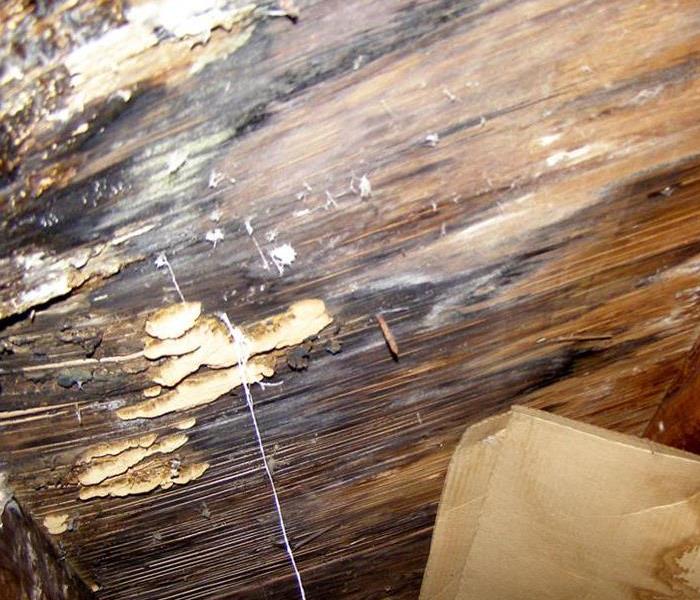 Dry Rot Under Tub
Dry Rot Under Tub
Your home is most likely one of your greatest investments. To protect your investment, it is important to be able to spot small problems before they become major expenses. Dry rot is one of those problems.
Dry rot is caused by a fungus that feeds on wood and weakens it. Wood becomes cracked and brittle and eventually breaks down. Dry rot is particularly a problem in older homes where wood may not have been treated to prevent rot damage.
Here are three things you should know about dry rot:
1) Where to look for dry rot.
Dry rot may sound as though it’s misnamed because fungus needs moisture to grow. Look in areas of your home where there is a water source.
Outside, you may find rot where there are damaged gutters or downspouts. Areas to check for rot include:
Wooden window sills.
Where water runs off the roof along with a wall.
Where a deck attaches to the home.
Where a vertical surface meets a horizontal surface.
Look for cracks, splits, and discoloration, which may indicate the presence of rot. Check the roof, especially areas where your home may have had a leak. Dry rot can also occur at points of a structure where wood meets the ground.
Inside, look for dry rot in areas where there may be a leaky pipe, unvented attic space, and damp basements or crawlspaces. Look for areas where drywall is water stained. Other areas to check include:
Rim joists, especially on a porch, crawlspace or basement.
Where wood meets a masonry floor or wall.
The floor around a tub or toilet.
You can check for rot with a pick or screwdriver. If it penetrates the wood or the wood flakes easily, there is rot. There may also be rot hidden behind flooring, drywall or siding, which may only be apparent by some discoloration or noticing the material does not feel structurally sound underweight or pressure.
2) What to do if you discover dry rot.
Dry rot is progressive so you will want to make repairs as soon as possible. You will first need to stop the source of the moisture. Replace wood that has been structurally weakened, possibly with pressure treated wood. Be sure the problem is properly diagnosed and not mistaken for damage done by carpenter ants.
Once you have found the source of moisture, repair the problem. If there is severe damage, pry off and replace the old wood. Be sure to temporarily support any structure before removing the old wood. Small areas of rot can be repaired with epoxy resin. If the wood is still structurally sound and the source of the moisture has been stopped, you can treat the area with borate, a fungicide, to stop the growth of the fungus and protect the wood from further damage.
3) How to prevent dry rot.
Rot occurs when there is wood combined with high moisture. To prevent rot, there are several things you can do around your house:
Properly ventilate and insulate your attic.
Properly ventilate crawlspaces.
Seal basement and crawlspace floors to reduce ground moisture.
Check all wall and roof flashing to ensure water is being directed properly.
Check deck and porch flashings.
Keep wood siding and trims off the ground and away from the roof and masonry.
Make sure all windows and doors are properly flashed.
Keep up with painting and caulking.
Keep drains and downspouts clear.
If there is considerable runoff near the house, consider installing a rain barrel to collect water or connecting your downspout to a drain tile that can move water a safe distance from your home.
Most importantly, treat dry rot as soon as it is discovered! Untreated dry rot can cause major damage to your home.
Keep Mold and Moisture Out of Your HVAC System
1/8/2018 (Permalink)
 Keeping the system clean is a healthy system.
Keeping the system clean is a healthy system.
In the warm summer heat, it's easy to build up moisture; especially when it gets sticky, muggy and humid. When this happens, you naturally crank the A.C., reach for something cold, and kick back in your lazy chair. The problem is, when you're relaxing and enjoying the nice cold breeze, the mold is spreading through your ducts, vents, and HVAC system, leaving a nasty haze of mold that you can smell all over the house. If you're running a business, your customers could smell it too- which is why you should always call our service professionals to deal with the problem as soon as possible.
How Does Mold Get in The HVAC System?
Mold damage in Chesterfield is no laughing matter. Mold, fungus, and other bacteria are in their perfect environment when they're trapped in your HVAC system. It's dark, warm, moist, closed in, and humid, meaning that spores can grow practically unabated. You'll notice more and more scent as heat and humidity is generated from outside and pulled through your ducts.
When this moist air gets in your air system, it collects within and above your HVAC units. At this point, the spores of mold and other fungi easily rise through the air, setting up colonies as your condenser forces them up through the duct system. These aren't the only cases of mold that we've seen at SERVPRO; we've seen mold stick to people's clothes or shoes, and it's all brought inside by excess humidity caused by rainfall.
Here Are a Few Tips on How to Remove Mold From Your HVAC System
1. Continue to clean and maintain your HVAC system, even when you aren't using it. Check the ducts for wet spots, and regularly check and maintain your HVAC filter.
2. Double check the drainage systems on your HVAC for mold. Allow for "dry-out" areas where the drainage comes out to prevent excess moisture.
3. Get dehumidifiers for your home. They are ideal for collecting excess humidity, and they help with the temperature inside your house, too.
4. Always insulate your pipes, walls, and ceilings. Use caulking for cracks to control cracks and leaks.
5. Contrary to common beliefs, keep your windows closed when it's hot outside. Humidity, dust, and dampness easily travel inside.
Warning Signs of Mold
1/8/2018 (Permalink)
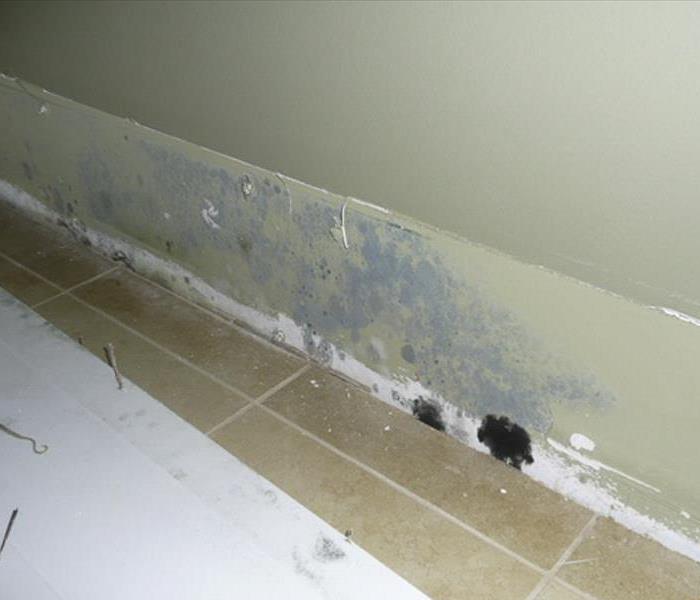 Best to keep it dry.
Best to keep it dry.
Nothing sends shivers through a homeowner's spine like mentioning the word "mold." Not only can it cause damage to your home and make it hard to sell, it also can be a health hazard to you and your family. Here are three warning signs of this insidious fungus that you don't want to ignore:
1) Water spots
Any wet spot in your home can be a potential sign of fungus growth. This can include water spots on your ceilings or walls, or on floors in your basement or crawlspace. If you find evidence of water spots, you need to find the potential moisture source and get it taken care of promptly. Using a highly-recommended remediation company like SERVPRO of South Chesterfield Wildwood is the best option.
2) Discoloration
If you find a spot on a wall or floor that's discolored, it is a potential sign of mold. Discoloration that is green or black is a definite warning sign of fungus growth. However, any discoloration can mean growth is present, even if it isn't of the tell-tale colors.
3) Bad smell
If you have fungus growth in your home, it can cause a bad smell. Depending on the type of growth and how much of it you have, you could have a very strong smell or one that is faint. It can smell musty or earthy, or it can produce a smell that is more pungent. Any bad smell needs to be investigated.
Mold can be harmful and is not something to be ignored. If you experience any of these warning signs, call SERVPRO of South Chesterfield Wildwood to investigate. Our staff receives extensive training on how to effectively deal with mold infestations. We also have the equipment and start of the art techniques to carry out remediation tasks and keep your home safe and clean.
The Professional Mold Remediation Process in Your Home or Business
12/29/2017 (Permalink)
The Professional Mold Remediation Process in Your Home or Business
Mold occurs naturally in the environment. It's a bacteria that plays a major role in the balancing of the ecosystem. Mold is found almost everywhere (indoors and outdoors) in the form of microscopic spores invisible to the naked eye. That being said, indoor mold beyond a certain level is not acceptable since it can lead to mold damage. This is why homeowners need to call mold remediation experts as soon as they spot mold growth.
Mitigation of Black Mold
As explained above, black mold occurs naturally. It's not possible to completely remove mold from your house or place of business; it can only be restored to natural levels through a process referred to as mold remediation or mold restoration. Complete mold removal is not possible. The term mold removal can also be used to mean mold remediation or restoration.
Attempting to remove the mold by yourself can lead to scattering and further spread. Call a professional. Do not disturb the mold. Turn off heaters and air conditioners to prevent migration of spores. Here's the general process of mitigation for mold in a home or mold growth behind a wall. Take a look.
Locating the Black Mold
Black mold thrives in moisture and can spread very quickly in a short span of time. Mold damage can lead to massive losses in a home or place of business. Mold blackens shower grout lines, leaves drywall discolored, among other damages. The physical mold growth behind the wall, mildew, dry rot, and fungus must be removed effectively.
But to do that, professionals have to locate the mold. Chances are that whatever can be seen isn't the only growth; there is more. Call a mold inspector to locate the mold growth behind the wall, mold growth on the ceiling, and any other hidden places where mold, mildew, dry rot, and fungus thrive. Both home and commercial mold damage can be restored through commercial mold damage restoration.
Assessing and Calculating Mold Damage
Locating the mold in a home is just the first step of mold remediation. Mold restoration company professionals have to assess the level of the home or commercial mold damage before commencing on the mold removal process. For mold, mildew, and fungus to be remediated properly, the professionals from the restoration company will have to find out the level of contaminated space, assess, and calculate the mold damage. This allows the professionals to give you a quote of the costs of mitigation, including deodorization — the process of removing the smelly odor — and any repairs.
Preparing the Damaged Area
Most mold removal professionals will use fungicides to remove mold, mildew, and fungus as well as deodorization. Tapes and sheets of plastic can be used to seal off the areas of work to prevent spreading spores to unaffected areas. During the mitigation of commercial mold damage, negative pressure is applied to the contained areas in order to prevent the spread of mold spores and smelly odor to unwanted areas. The source of moisture has to be addressed at this level.
Cleaning Up and Removing Mold Growth
This is most important part of the mold removal process. The ease of mold growth clean-up process will depend on the extent of the mold growth behind the walls, type of mold (there are many types and strains), and other factors. The dry rot behind the walls and the ceiling will be thoroughly removed and sealed in waste bags for proper disposal. Professionals will use a vacuum with a HEPA filter to avoid dispersing mold spores. The last step of the process will be to remove the smelly odor via deodorization. The restoration company that removes the mold in a home or office will use powerful air scrubbers during the deodorization process to clear any traces of smelly odor.
Repairs
Professionals will thoroughly vacuum the removed mold in a home to prevent damage, and afterward, the vacuum is cleaned with fungicides to make sure any traces of mold deposits are removed. Fungus, mold, and mildew grow on different surfaces in a home including walls, ceilings, bathtubs, et cetera. The removal of the dry rot leaves some of these surfaces partially or completely damaged, and there is the need for repairs to be carried out by the restoration company to get your home back to pre loss conditions.
Visit http://www.SERVPROsouthchesterfieldwildwood.com/mold-remediation
Control mold growth is to control moisture in Chesterfield, MO
12/27/2017 (Permalink)
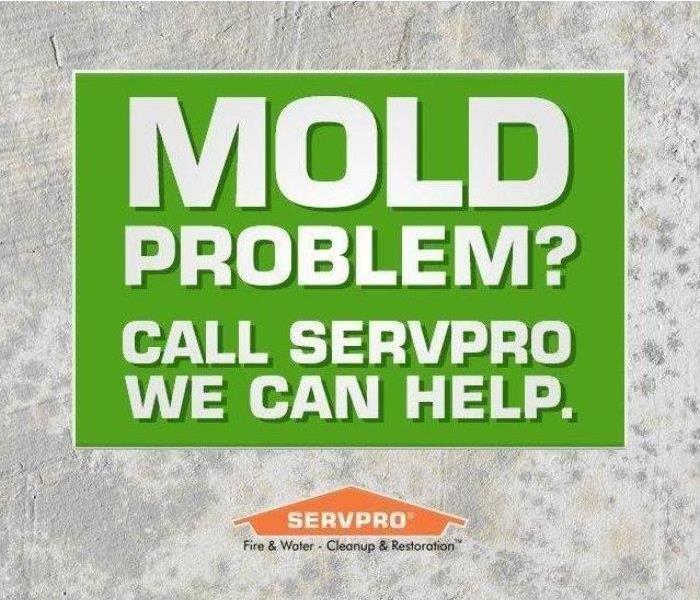 Got Mold We Can Help.
Got Mold We Can Help.
SERVPRO Of South Chesterfield Wildwood had the training and tools to take care of mold in side our homes.
Molds are part of the natural environment, and can be found everywhere, indoors and outdoors. Mold is not usually a problem, unless it begins growing indoors. The best way to control mold growth is to control moisture.
It only takes a small water leak, or even excess humidity, for mold to form in your Chesterfield home or business. Then, mold can spread quickly through the property in as little as 48 hours. Mold can produce allergens and irritants, and it has the potential to cause other health effects. If your home or business has a mold problem, we can inspect and assess your property and use our specialized training, equipment, and expertise to remediate your mold infestation.
Why do I need mold testing if I already know I have a mold problem?
12/22/2017 (Permalink)
 Suspect Mold We Can Help
Suspect Mold We Can Help
Why do I need mold testing if I already know I have a mold problem?
Most certified, reputable mold remediation contractors will require you to have a mold inspection with an air sample analysis and corresponding remediation plan prior to providing you with an estimate. The mold report will define the extent and severity of the problem and what the proper remediation plan, procedures and protocols should be from and independent, unbiased person (environmental consultant). It gives a starting point of the environment as it relates to airborne mold spore counts so we can gauge the effectiveness of the remediation contractor at the end of the project for the post-remediation verification aka clearance.
The Mold Remediation Process
Every mold damage scenario is different, and requires a unique solution, but the general mold remediation process stays the same. The steps listed below illustrate our “typical” process:
- Emergency Contact - (636) 537-5400
- Inspection and Mold Damage Assessment
- Mold Containment
- Air Filtration
- Removing Mold and Mold-Infested Materials
- Cleaning Contents and Belongings
- Restoration
Getting Professional Help For Water Removal In Your Chesterfield Home From A Hidden Bathroom Leak
12/20/2017 (Permalink)
 Mold removal is what we do.
Mold removal is what we do.
Professional Water Removal
A hidden water leak in your bathroom, if left untreated, can cost you, especially if it leads to serious damage to walls, flooring, and paint. There are subtle signs you can look for in your Chesterfield Wildwood home to figure out whether you need a plumber to fix those leaking fixtures and pipes before things get worse. When you have a massive leak, you need a certified remediation company to help you clean up the damage, such as SERVPRO.
One sign of a hidden leak and the need for professional water removal is a wall which has blistering wallpaper or paint. Most of the time, steam from hot showers in your Dallas home should not cause this to happen. When water and moisture get between the paint and the wall, they stop the bond and start to separate the two, making the paint rise from the wall and all off in bits. It is the same case with wallpaper.
A wall which is warped or stained for no apparent reason is a clear sign of a plumbing leak. Drywall becomes soft and starts to bubble when it is exposed to moisture, eventually warping and breaking up into pieces. If the leak reaches your ceiling, it will sag and could leak some of the accumulated water, causing more damage to your bathroom.
At SERVPRO, our technicians have tools like moisture meters to find any hidden moisture and leaks in your bathroom and to remove any accumulation of water from those leaks. We first figure out what is causing the leak, fix the problem, and eliminate the water with industrial pumps, fans, and dehumidifiers. Quickly drying your bathroom out is important to avoid the growth of mold. Once your bathroom is dry again, repairs are made, including replacing any damaged drywall, and the affected area is sanitized.
Sometimes your flooring can be damaged as well if the leak was bad enough, causing cracking, staining or buckling. Moisture can make your floor feel soft or spongy depending upon the material it is made of. In these cases, you often find a damp subfloor as well. If the problem is found quick enough, we can dry it out and salvage it without having to replace it, but we may need to put new sub-flooring in as well where the water damaged it.


 24/7 Emergency Service
24/7 Emergency Service








